1998 VOLVO V90 cooling
[x] Cancel search: coolingPage 27 of 175

1998 Volvo S90
Anti-lock Brake
System (ABS)
If the warning lamp lights up
there is a malfunction of the
ABS system (the standard
braking system will however
function). The vehicle should be
driven to a Volvo retailer for
inspection.
See page 67 for additional
information.
Canadian models are equipped
with this warning light:
Mode "W" engaged
The lamp will light up when the
Winter/Wet mode is engaged.
If the warning lamp begins to
flash,this means that there is a
fault in the automatic gearbox.
Contact your Volvo retailer.
Supplemental
Restraint System
If the light comes on (or stays
on after the vehicle has started),
the SRS diagnostic system has
detected a fault. Drive to an
authorized Volvo retailer for an
inspection of the system. See
the SRS section for more
information.
Service reminder
indicator
This light will come on at
10,000 mile (16,000 km)
intervals. It is a reminder to the
driver that the 10,000 mile
(16,000 km) service interval has
been exceeded. The light will
stay on 2 minutes after start
until reset by the servicing
retailer.
Coolant level sensor
If the light comes on while
driving, the coolant level is low.
The coolant level in the
expansion tank should be
checked immediately and
topped off if necessary. The
cooling system should be
inspected by an authorized
Volvo retailer.
Turn signal indicators-
trailer (certain models)
When towing a trailer, this light
will flash simultaneously with
the turn signals on the trailer. If
the light does not flash when
signaling, neither the trailer's turn
signals nor the car's turn signals
are functioning.
Bulb failure warning
light
The light will come on if any of
the following bulbs are defective:
one of the low beam headlights
one of the tail lights
one of the brake lights when the
brake pedal is depressed.
Check the fuse and bulb.
See sections titled "Replacing
bulbs" and "Fuses".
Lighting, Turn signals pg. 20
file:///K|/ownersdocs/1998/1998_SV90/98S90_017.htm (3 of 7)12/30/2006 \
1:52:36 PM
Page 37 of 175

1998 Volvo S90
*When the function selector is in the
mode, the air conditioning
system is ON and recirculation is OFF, regardless
of button position. The light surrounding the "Snowflake" button will be\
OFF and the light surrounding the recirculation button will be OFF.
NOTE: If your windows begin to fog or mist, check that the
recirculation function is not engaged.
Heating, ventilation and air conditioning (cont.) pg. 27
Automatic setting
The ECC system will automatically
maintain a comfortable in-car
temperature regardless of the outdoor
temperature.
Select the desired temperature
The blower will run at its maximum
speed in either the max cooling or max
Operating Tips
Recirculation: When the
outside air is contaminated
with exhaust gases, smoke
etc. (as when driving
through a tunnel) or to cool
the car quickly, push the
recirculation button. In this
position, no air is drawn into
the passenger compartment
from outside. However, do
not leave the system in this
mode for more than 10-15
minutes, since the air inside
the car will become stale
and the windows may fog.
Recirculation (and the
indicator light) will also
come on when the interior of
the car is hot and a low
temperature is selected with
the temperature dial. This
helps speed cooling of the
passenger compartment. It
will switch off automatically
after several minutes.
Difficult weather
conditions
When driving in very humid ECC system fault
indication
If the light in the air
conditioning push button
begins to flash when the
ignition is switched on, a
simple fault is indicated.
The system will compensate
by substituting a standard
value stored in the memory.
System performance loss
will be slight.
If the light continues to flash
more than 20 seconds, a
more serious fault is
indicated. While the system
will again attempt to
substitute a standard value,
some reduction in system
performance will become
apparent. Contact your
authorized Volvo retailer for
service.
file:///K|/ownersdocs/1998/1998_SV90/98S90_023.htm (6 of 7)12/30/2006 \
1:52:37 PM
Page 69 of 175
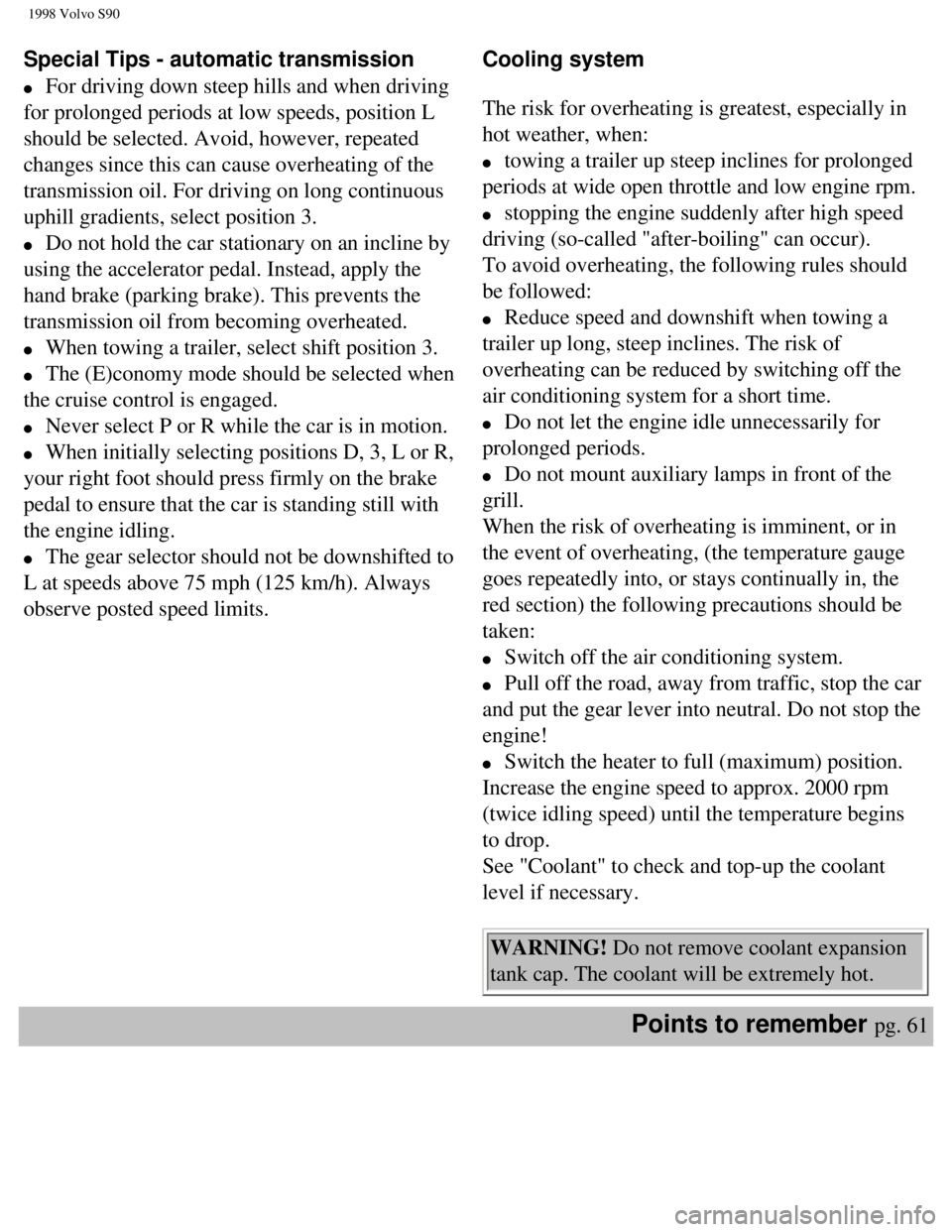
1998 Volvo S90
Special Tips - automatic transmission
l For driving down steep hills and when driving
for prolonged periods at low speeds, position L
should be selected. Avoid, however, repeated
changes since this can cause overheating of the
transmission oil. For driving on long continuous
uphill gradients, select position 3.
l Do not hold the car stationary on an incline by
using the accelerator pedal. Instead, apply the
hand brake (parking brake). This prevents the
transmission oil from becoming overheated.
l When towing a trailer, select shift position 3.
l The (E)conomy mode should be selected when
the cruise control is engaged.
l Never select P or R while the car is in motion.
l When initially selecting positions D, 3, L or R,
your right foot should press firmly on the brake
pedal to ensure that the car is standing still with
the engine idling.
l The gear selector should not be downshifted to
L at speeds above 75 mph (125 km/h). Always
observe posted speed limits. Cooling system
The risk for overheating is greatest, especially in
hot weather, when:
l towing a trailer up steep inclines for prolonged
periods at wide open throttle and low engine rpm.
l stopping the engine suddenly after high speed
driving (so-called "after-boiling" can occur).
To avoid overheating, the following rules should
be followed:
l Reduce speed and downshift when towing a
trailer up long, steep inclines. The risk of
overheating can be reduced by switching off the
air conditioning system for a short time.
l Do not let the engine idle unnecessarily for
prolonged periods.
l Do not mount auxiliary lamps in front of the
grill.
When the risk of overheating is imminent, or in
the event of overheating, (the temperature gauge
goes repeatedly into, or stays continually in, the
red section) the following precautions should be
taken:
l Switch off the air conditioning system.
l Pull off the road, away from traffic, stop the car
and put the gear lever into neutral. Do not stop the
engine!
l Switch the heater to full (maximum) position.
Increase the engine speed to approx. 2000 rpm
(twice idling speed) until the temperature begins
to drop.
See "Coolant" to check and top-up the coolant
level if necessary.
WARNING! Do not remove coolant expansion
tank cap. The coolant will be extremely hot.
Points to remember pg. 61
file:///K|/ownersdocs/1998/1998_SV90/98S90_058.htm (4 of 7)12/30/2006 \
1:52:42 PM
Page 77 of 175
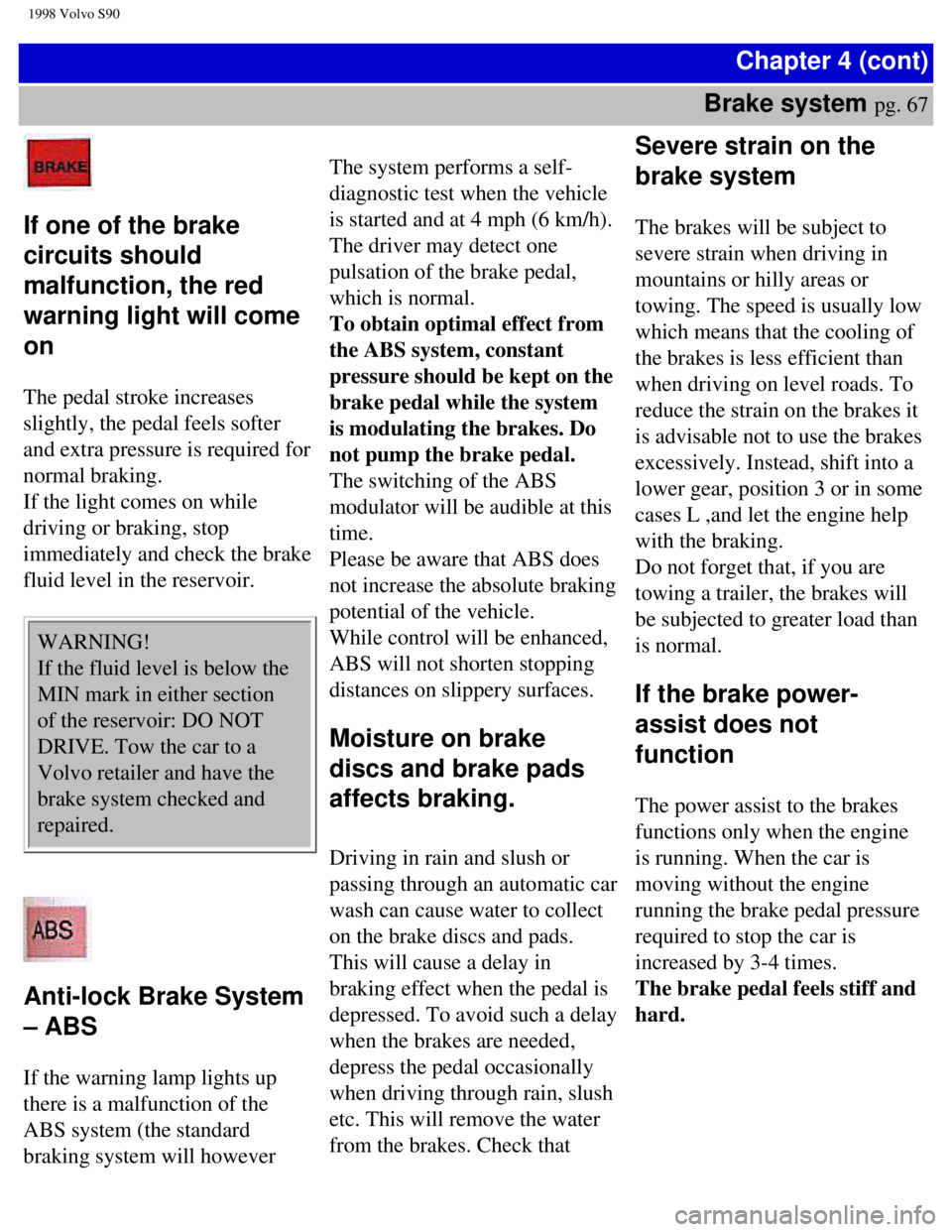
1998 Volvo S90
Chapter 4 (cont)
Brake system
pg. 67
If one of the brake
circuits should
malfunction, the red
warning light will come
on
The pedal stroke increases
slightly, the pedal feels softer
and extra pressure is required for
normal braking.
If the light comes on while
driving or braking, stop
immediately and check the brake
fluid level in the reservoir.
WARNING!
If the fluid level is below the
MIN mark in either section
of the reservoir: DO NOT
DRIVE. Tow the car to a
Volvo retailer and have the
brake system checked and
repaired.
Anti-lock Brake System
– ABS
If the warning lamp lights up
there is a malfunction of the
ABS system (the standard
braking system will however
The system performs a self-
diagnostic test when the vehicle
is started and at 4 mph (6 km/h).
The driver may detect one
pulsation of the brake pedal,
which is normal.
To obtain optimal effect from
the ABS system, constant
pressure should be kept on the
brake pedal while the system
is modulating the brakes. Do
not pump the brake pedal.
The switching of the ABS
modulator will be audible at this
time.
Please be aware that ABS does
not increase the absolute braking
potential of the vehicle.
While control will be enhanced,
ABS will not shorten stopping
distances on slippery surfaces.
Moisture on brake
discs and brake pads
affects braking.
Driving in rain and slush or
passing through an automatic car
wash can cause water to collect
on the brake discs and pads.
This will cause a delay in
braking effect when the pedal is
depressed. To avoid such a delay
when the brakes are needed,
depress the pedal occasionally
when driving through rain, slush
etc. This will remove the water
from the brakes. Check that
Severe strain on the
brake system
The brakes will be subject to
severe strain when driving in
mountains or hilly areas or
towing. The speed is usually low
which means that the cooling of
the brakes is less efficient than
when driving on level roads. To
reduce the strain on the brakes it
is advisable not to use the brakes
excessively. Instead, shift into a
lower gear, position 3 or in some
cases L ,and let the engine help
with the braking.
Do not forget that, if you are
towing a trailer, the brakes will
be subjected to greater load than
is normal.
If the brake power-
assist does not
function
The power assist to the brakes
functions only when the engine
is running. When the car is
moving without the engine
running the brake pedal pressure
required to stop the car is
increased by 3-4 times.
The brake pedal feels stiff and
hard.
file:///K|/ownersdocs/1998/1998_SV90/98S90_067.htm (1 of 5)12/30/2006 \
1:52:43 PM
Page 83 of 175

1998 Volvo S90
When replacing tires, be sure that the new tires
are the same size designation, type (radial) and
preferably from the same manufacturer, on all
four wheels. Otherwise there is a risk of altering
the car's road-holding and handling
characteristics.
NOTE:When storing wheel/tire assemblies (e.g.
winter tires and wheels), either stand the
assemblies upright or suspend them off the
ground. Laying wheel/tire assemblies on their
sides for prolonged periods can cause wheel and/
or tire damage.
Wear indicator
The tires have a so-called "wear indicator" in the
form of a number of narrow strips running across
or parallel to the tread. When approx. 1/16" (1.6
mm) is left on the tread, these strips show up and
indicate that the tire should be replaced.
Tires with less than 1/16" (1.6 mm) tread have a
very poor grip in rain or snow.
All tires become warm during use. After cooling,
when the vehicle is parked, the tires have a
tendency to distort slightly, forming flat spots.
These flat spots can cause vibrations similar to the
vibrations caused by imbalanced wheels.
They do, however, disappear when the tire warms
up. The degree to which the flat spots form
depends on the type of cord used in the tire.
Remember that, in cold weather, it takes longer
for the tire to warm up and consequently longer
for the flat spot to disappear.
Wheels and tires (cont.) pg. 73
Snow chains
Snow tire chains can be used on your Volvo with
the following restrictions:
l Snow chains should be installed on rear wheels
only. Use only Volvo approved snow chains.
l Snow chains can only be used on tires which
are not wider than 195 mm.
l Sufficient clearances between chains and
brakes, suspension and body components must be
maintained.
l Some strap-on type chains will interfere with
brake components and therefore CANNOT be
used.
Consult your Volvo retailer for additional snow
Snow tires, studded tires*
Tires for winter use:
Owners who live in or regularly commute
through areas with sustained periods of snow
or icy driving conditions are strongly advised
to fit suitable winter tires to help retain the
highest degree of traction.
It is important to install winter tires on all four
wheels to help retain traction during cornering,
braking and accelerating. Failure to do so could
reduce traction to an unsafe level or adversely
affect handling. Do not mix tires of different
design as this could also negatively affect overall
tire road grip.
file:///K|/ownersdocs/1998/1998_SV90/98S90_071.htm (2 of 5)12/30/2006 \
1:52:44 PM
Page 99 of 175
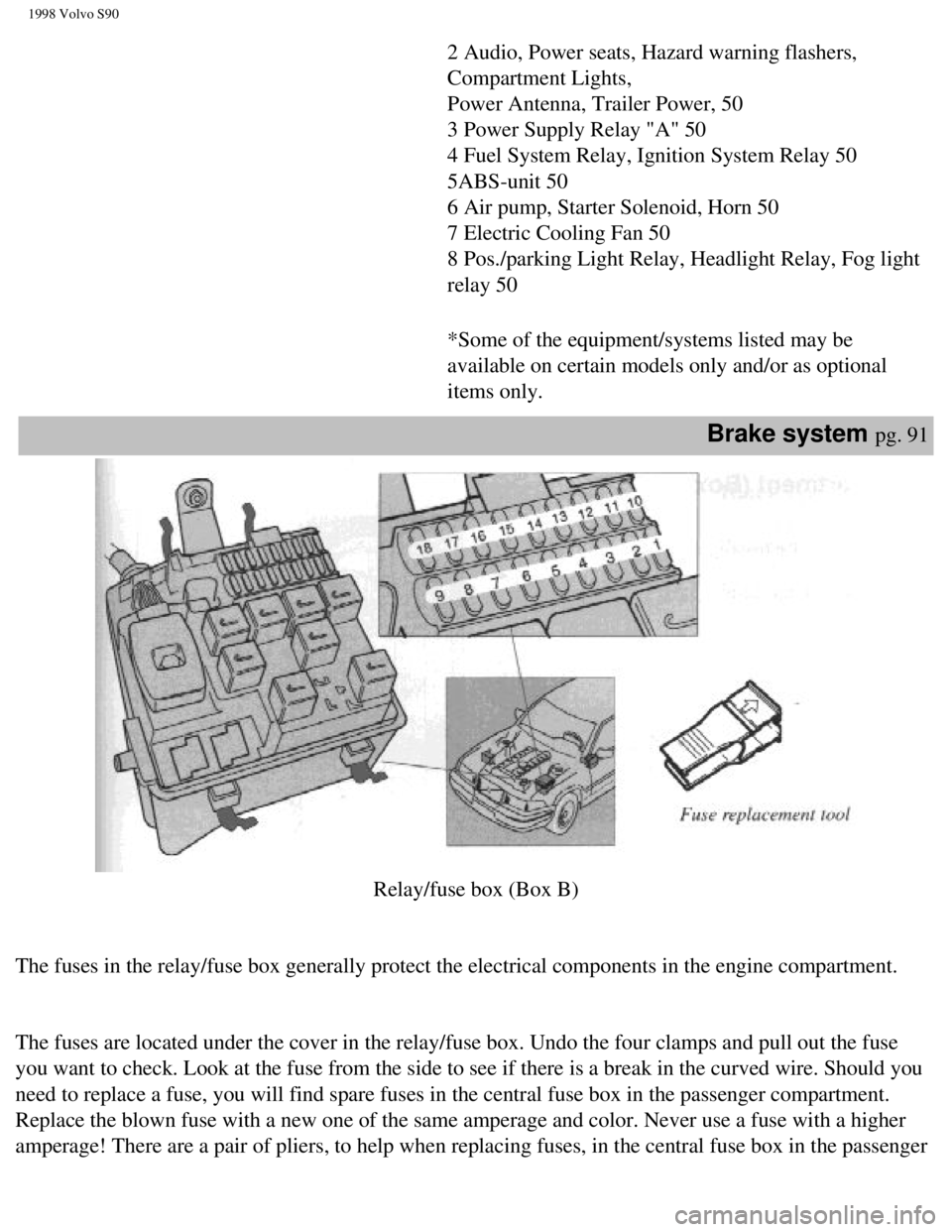
1998 Volvo S90
2 Audio, Power seats, Hazard warning flashers,
Compartment Lights,
Power Antenna, Trailer Power, 50
3 Power Supply Relay "A" 50
4 Fuel System Relay, Ignition System Relay 50
5ABS-unit 50
6 Air pump, Starter Solenoid, Horn 50
7 Electric Cooling Fan 50
8 Pos./parking Light Relay, Headlight Relay, Fog light
relay 50
*Some of the equipment/systems listed may be
available on certain models only and/or as optional
items only.
Brake system pg. 91
Relay/fuse box (Box B)
The fuses in the relay/fuse box generally protect the electrical compone\
nts in the engine compartment.
The fuses are located under the cover in the relay/fuse box. Undo the fo\
ur clamps and pull out the fuse
you want to check. Look at the fuse from the side to see if there is a b\
reak in the curved wire. Should you
need to replace a fuse, you will find spare fuses in the central fuse bo\
x in the passenger compartment.
Replace the blown fuse with a new one of the same amperage and color. Ne\
ver use a fuse with a higher
amperage! There are a pair of pliers, to help when replacing fuses, in t\
he central fuse box in the passenger
file:///K|/ownersdocs/1998/1998_SV90/98S90_089.htm (3 of 9)12/30/2006 \
1:52:46 PM
Page 112 of 175
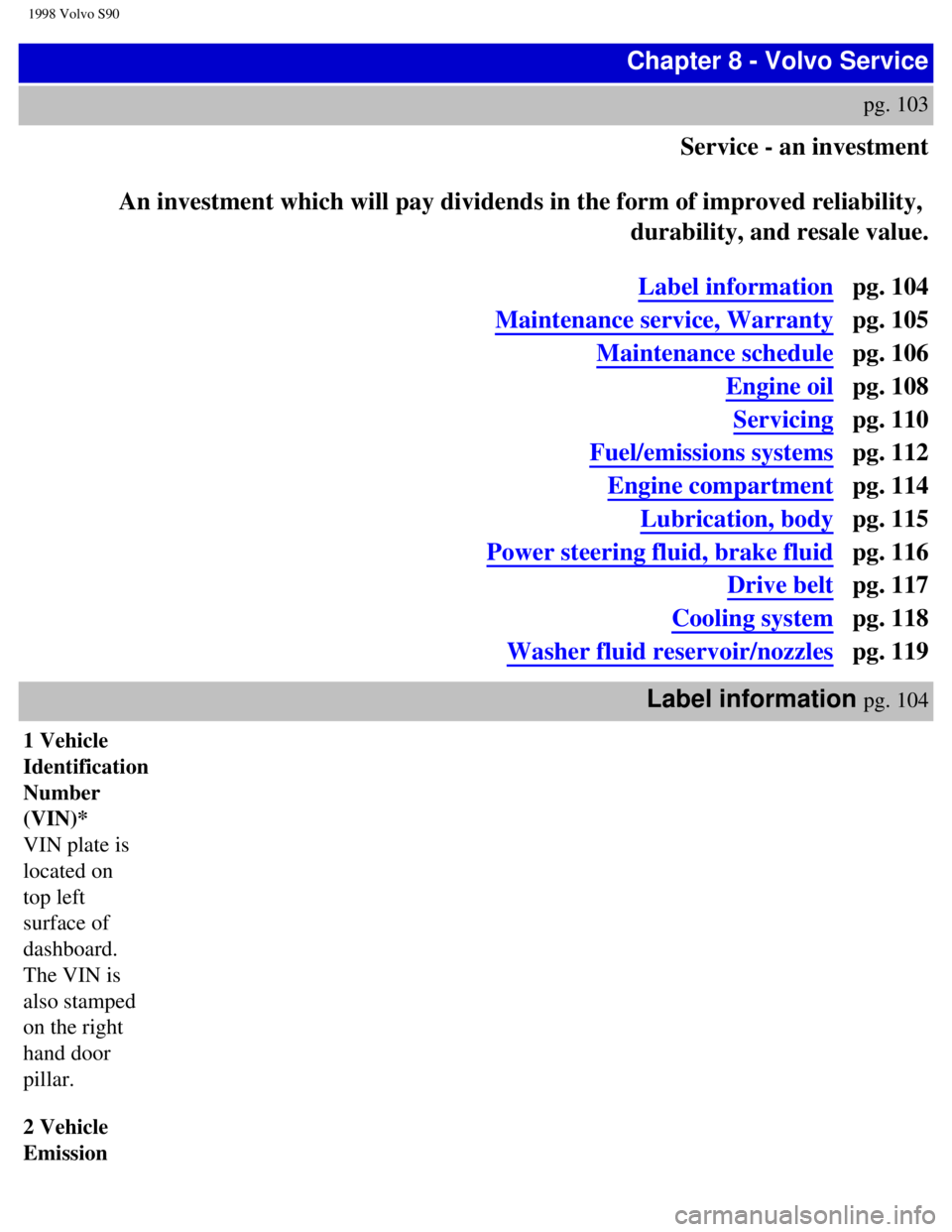
1998 Volvo S90
Chapter 8 - Volvo Service
pg. 103
Service - an investment
An investment which will pay dividends in the form of improved reliabili\
ty,
durability, and resale value.
Label information pg. 104
Maintenance service, Warranty pg. 105
Maintenance schedule pg. 106
Engine oil pg. 108
Servicing pg. 110
Fuel/emissions systems pg. 112
Engine compartment pg. 114
Lubrication, body pg. 115
Power steering fluid, brake fluid pg. 116
Drive belt pg. 117
Cooling system pg. 118
Washer fluid reservoir/nozzles pg. 119
Label information
pg. 104
1 Vehicle
Identification
Number
(VIN)*
VIN plate is
located on
top left
surface of
dashboard.
The VIN is
also stamped
on the right
hand door
pillar.
2 Vehicle
Emission
file:///K|/ownersdocs/1998/1998_SV90/98S90_103.htm (1 of 7)12/30/2006 \
1:52:48 PM
Page 125 of 175
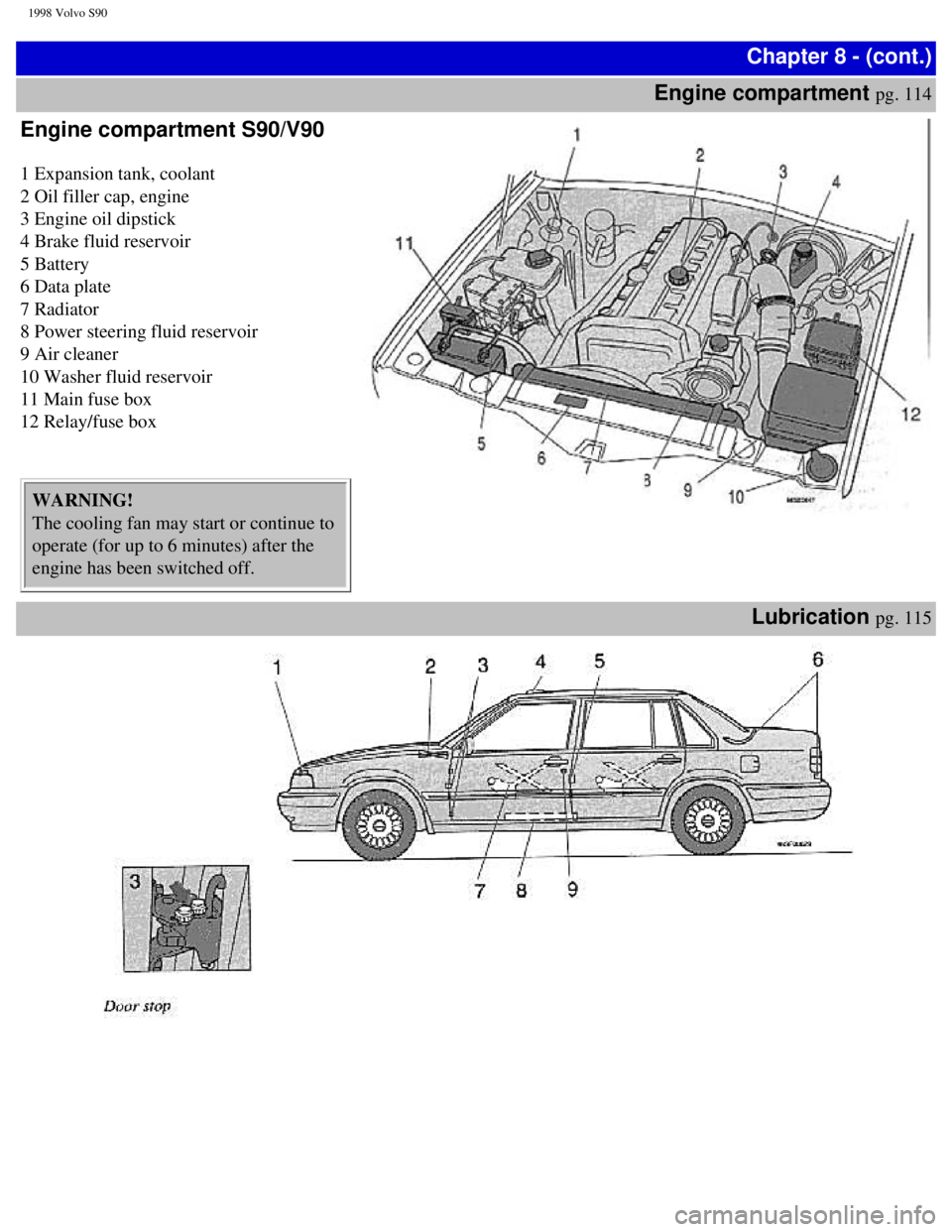
1998 Volvo S90
Chapter 8 - (cont.)
Engine compartment
pg. 114
Engine compartment S90/V90
1 Expansion tank, coolant
2 Oil filler cap, engine
3 Engine oil dipstick
4 Brake fluid reservoir
5 Battery
6 Data plate
7 Radiator
8 Power steering fluid reservoir
9 Air cleaner
10 Washer fluid reservoir
11 Main fuse box
12 Relay/fuse box
WARNING!
The cooling fan may start or continue to
operate (for up to 6 minutes) after the
engine has been switched off.
Lubrication pg. 115
file:///K|/ownersdocs/1998/1998_SV90/98S90_114.htm (1 of 5)12/30/2006 \
1:52:50 PM